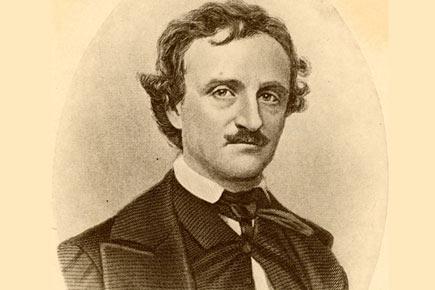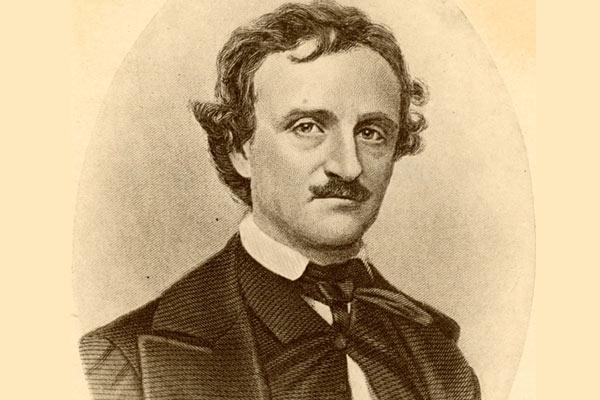On Noted American author, poet, editor, and literary critic Edgar Allan Poe's 206th birth anniversary, we look at a selection of Edgar Allan Poe's works, that succeeded in making an impact on popular culture and mass media

Edgar Allan Poe, American author, Death Anniversary, The Raven, The Murders in the Rue Morgue, The Purloined Letter, The Gold Bug, The Mystery of Marie Roget
Noted American author, poet, editor, and literary critic Edgar Allan Poe was born today in January 19, 1809. Well-known to try to earn a living through writing alone, Poe went through a financially difficult life and career.
Best known for his tales of mystery and the macabre, Poe was one of the earliest American practitioners of the short story, and is generally considered the inventor of the detective fiction genre. He is further credited with contributing to the emerging genre of science fiction.
We look at a selection of Edgar Allan Poe's works, that succeeded in making an impact on popular culture and mass media.

An undated portrait of Edgar Allan Poe
The Raven: This dark, gloomy, narrative poem with supernatural undertones by Edgar Allan Poe was first published in January 29 1845. Its publication made Poe widely popular in his lifetime. Although it did not bring him much financial success, 'The Raven' nevertheless remains one of the most famous poems ever written.
The poem tells the story of a talking raven's mysterious visit to a distraught lover, tracing the man's slow fall into madness. The lover, often identified as being a student, is lamenting the loss of his love, Lenore. Sitting on a bust of Pallas, the raven seems to further instigate his distress with its constant repetition of the word "Nevermore".
'The Raven' has been frequently adapted in many books, magazines, the big screen and television.
The poem was adpated for the first time on screen as a hallucination of Edgar Allan Poe's in the 1915 silent film The Raven. The movie was a fictionalized biography, it starred actor Henry B. Walthall as Poe.
Apart from the poem, its lines and Edgar Allan Poe himself were referenced to in several films, most notably the 1935 and 1963 films, which were both titled 'The Raven', the former which starred horror legends Boris Karloff and Bela Lugosi, the 1989 blockbuster 'Batman', with Jack Nicholson playing the Joker quoting a few lines from the poem, 'The Crow' starring Bruce Lee's late son Brandon Lee, the 2010 action blockbuster 'The Expendables' and many others.
Most recently in 2012, a film titled after Poe's poem starred actor John Cusack as Edgar Allan Poe. Set in 1849, it is a fictionalized account of the last days of Edgar Allan Poe's life, in which the poet and author pursues a serial killer whose murders mirror those in Poe's stories. While the plot of the film is fictional, the writers based it on some accounts of real situations surrounding Edgar Allan Poe's mysterious death. Poe is said to have repeatedly called out the name "Reynolds" on the night before his death, though it is unclear to whom he was referring. Panned by critics, the film just made back its budget. The visual effects garnered praise, as did the musical score by Lucas Vidal.
On print, 'The Raven' was parodied by MAD Magazine several times, the first of which was published in March 1954, with absurd illustrations.
On television, the poem was famously spoofed on 'The Simpsons' in the third segment of their Halloween-themed episode 'Treehouse of Horror'. While a few stanzas from the original poem are used, much of the story is cut from this segment of the episode.
The Murders in the Rue Morge: Edgar Allan Poe introduced the detective character C. Auguste Dupin to the readers in this short story. It is widely considered the first detective fiction. As the first fictional detective, Poe's Dupin displays many traits which became literary conventions in subsequent fictional detectives including Sherlock Holmes and Hercule Poirot.
In the story, C. Auguste Dupin is a man in Paris who solves the mystery of the brutal murder of two women. Numerous witnesses heard a suspect, though no one agrees on what language was spoken. At the murder scene, Dupin finds a hair that does not appear to be human. Many later characters, for example, follow Poe's model of the brilliant detective, his personal friend who serves as narrator, and the final revelation being presented before the reasoning that leads up to it.
Poe created the Dupin character before the word detective had been coined. The character laid the groundwork for fictitious detectives to come, including Sherlock Holmes, and established most of the common elements of the detective fiction genre.
Poe's The Murders in the Rue Morge has been adapted on the silver screen and television several times, though most of them had little to do with the original story.
The first film adaptation was a short silent film made in 1917 and the first full-length version was Murders in the Rue Morgue by Universal Pictures in 1932, directed by Robert Florey and starring Bela Lugosi, Leon Ames, and Sidney Fox, with Arlene Francis.
The Mystery of Marie Rogêt: Edgar Allan Poe's detective character C. Auguste Dupin reappears in this 1842 short story, which is the first murder mystery based on the details of a real crime.
In The Mystery of Marie Rogêt, C. Auguste Dupin and his sidekick the unnamed narrator undertake the unsolved murder of Marie Rogêt, a perfume shop employee, is found in the Seine River in Paris. The story details how Dupin uses his analytical skills to uncover the culprit.
A film based on the story was adapted in 1942 by Universal Pictures as a gothic mystery film. Directed by Phil Rosen, the film starred Patric Knowles, Maria Ouspenskaya and Maria Montez.
The Purloined Letter: C. Auguste Dupin makes his third and final appearance in this Poe short story. The plot revolves around how Dupin recovers a letter that was stolen from the boudoir of an unnamed female by a unscrupulous minister.
The story has certain similarities to three Sherlock Holmes stories by Sir Arthur Conan Doyle, "The Second Stain", "The Adventure of the Naval Treaty", and "A Scandal in Bohemia". It has been adapted twice, first in the 1950s TV series Suspense and later in an episode for the 1995 children's show Wishbone.
The Gold Bug: Edgar Allan Poe had a keen interest in cryptography, which led him to write the short story titled "The Gold-Bug" incorporating ciphers as an essential part of the story. The sensation Poe created with his cryptography stunts played a major role in popularizing cryptograms in newspapers and magazines.
The plot follows William Legrand, who was recently bitten by a gold-colored bug. His servant, Jupiter, fears Legrand is going insane and goes to Legrand's friend, an unnamed narrator, who agrees to visit his old friend. Legrand pulls the other two into an adventure after deciphering a secret message that will lead to a buried treasure.
Poe became aware of the public's interest in secret writing in 1840 and asked readers to challenge his skills as a code-breaker. Poe took advantage of the popularity of cryptography as he was writing "The Gold-Bug", and the success of the story centers on one such cryptogram.
Poe submitted "The Gold-Bug" as an entry to a writing contest sponsored by the Philadelphia Dollar Newspaper. His story won the grand prize and was published in three installments, beginning in June 1843. The prize also included $100, probably the largest single sum Poe received for any of his works. "The Gold-Bug" was an instant success and was the most popular and most widely read of Poe's works during his lifetime.
The story proved popular enough in its day that a stage version opened on August 8, 1843.
In film and television, an adaptation of the work appeared on Your Favorite Story on February 1, 1953.
"The Gold Bug" episode on the 1980 ABC Weekend Special series, which starred Roberts Blossom as Mr. LeGrand, Geoffrey Holder as Jupiter, and Anthony Michael Hall, won three Daytime Emmy Awards.
ADVERTISEMENT
 Subscribe today by clicking the link and stay updated with the latest news!" Click here!
Subscribe today by clicking the link and stay updated with the latest news!" Click here!







